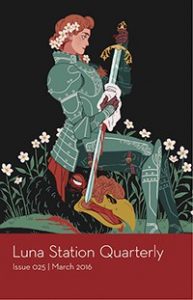
Hello! Welcome to the very first Words for Thought. I'm incredibly grateful to Jason Sizemore and Apex Magazine for giving me space to talk about short fiction and to highlight some recent stories I've loved. My vision for Words for Thought is to create a review column with a look at fiction as a conversation. I'll discuss works that speak to each other through theme or tone, or that speak to me particularly as a reader. This first batch of stories is about flying, falling, jumping, and staying aloft, as well as the uses and abuses of bodies, consumption, what remains hidden, and what people choose not to see.
In "Cloud Dweller" by E. Catherine Tobler from Issue #199 of Beneath Ceaseless Skies, set in the world of Jackson's Unreal Circus and Mobile Marmalade, Vasily Agranovsky is a tightrope walker with the uncanny ability to walk on thin air. He sees lines no one else can see, and feels compelled to walk them, an act of faith when his logical mind tells him he should fall. Tobler offers up a circus story that is also a ghost story, among other things. She neatly draws a line between Vasily's profession, and his past. To look down is death for a tightrope walker. For Vasily— a Russian Jew fleeing the pogroms— looking back is just as dangerous. Despite his best efforts, ghosts find Vasily. He feels vibrations in the lines as he walks, and another set of feet under his. Giving in to the temptation to look down, he discovers a man who looks just like him, a ghostly twin, surrounded by an impossible city.
Whatever the other walker represented, it was possible that no other person in this world could see him. If Vasily refused to see and did not acknowledge the other’s desperation, what would that mean?
"Cloud Dweller" explores responsibility, and the choice to act or to turn away from someone in need. One path is safety, and the other is risk, but Vasily has spent his whole life stepping out onto a wire and trusting the sky not let him fall. It's a powerful story, wrapped in Tobler's usual lush prose. The characters feel lived in, and there is a sense of weight and history to every one of them. Like Vasily's ghost city, there is a whole larger world tucked inside this story, waiting to unfold.
"Flightcraft" by Iona Sharma from the Spring issue of Luna Station Quarterly centers on characters dealing with the fallout of war and violence. Catriona McDonald is an aircraft engineer skilled in the magical use of ink and folded paper to build better airplanes. She accepts a commission to build a plane that can fly longer distances, and ends up taking on her patron's son, Toby, as an apprentice. Cat also befriends Talitha Cawthorne, a woman who seems to know something of flightcraft, but is vague about that knowledge and her role in the war. An accident at the warehouse causes part of Cat's new plane to collapse, trapping Toby underneath, and forcing Cat and Talitha to push the limits of their magical abilities to save him. In the wake of the accident, both women must to come to terms with their pasts and their actions in the war. For all that "Flightcraft" is a story laced with magic, it is a story about practicality as well. Cat and Talitha make hard choices out of necessity and live with the consequences, and Sharma creating an interesting parallel between the freedom of flight and the weighty responsibility it brings.
"Left the Century to Sit Unmoved" by Sarah Pinsker, published by Strange Horizons, is a story about jumping rather than flying. There is a pond in the town where the narrator, Shay, lives that people have been jumping into for years. Every now and then, someone disappears. Their clothes are left behind, but their bodies are never found. There are rules for jumping that are meant to keep people safe, but like Vasily in "Cloud Dweller," jumping into the pond is a matter of faith. Safety is not guaranteed. Shay's older brother is one of the disappeared, but that doesn't stop Shay from jumping. Pinsker uses the list-as-narrative structure to good effect throughout story, when it comes to the rules of the pond, and the reasons people continue jumping.
We jump because we have to.
We jump because we can.
We jump because we dare ourselves.
We jump because we're lonely.
We jump because we want to be alone.
The pond and the act of jumping could stand in a metaphor for any number of things— falling in love, growing up, finding yourself. With an economy of words, Pinsker neatly encapsulates all these dangers that come with simply being alive, as well as the reasons why the risks are worthwhile. Jumping is a choice, falling is freedom, and sometimes you just have to take it on faith that when you launch yourself into the sky you won't drown.
"The Signal Birds" by Octavia Cade from the debut issue of Liminal Stories is a story about war itself, rather than its aftermath. Here, women sprout metallic feathers from their skin, but the feathers don't allow them to fly. The only thing they're useful for is amplifying radio signals and catching transmissions. As such, the women are put to work as tools in the war effort, no better than pieces of equipment. It's better than starving, but barely; the war wears them down, and the feathers constantly pushing through their skins bring pain, scars, and the risk of infection. The story is lovely and painful all at once, taking something that should be wondrous— women with wings— and making it twisted and ugly. Cade mirrors the signal birds on the Allies' side with German women forced into a constant cycle of birthing babies who will grow up to be soldiers. "The Signal Birds" explores women's bodies as fodder to be used and abused and ground up by the war machine, and shows the futility of war from the point of view of those on the ground-level. Like Sharma's "Flightcraft," Cade draws a correlation between freedom, flight, and responsibility. The women's wings should be marvelous things lifting them up and giving them freedom, but instead, they are the very things weighing them down and tying them to their wartime duty.
"The Haferbräutigam" by Steve Berman from the May issue of The Dark isn't a war story, but it is a story about the uses and abuses of bodies, and the things people choose not to see. Plüschow is a photographer recently jailed for his relationship with a young man. Now that he's free, he travels to Germany where he encounters young man who is just his type— seemingly naive, out of place, a simple farm boy— someone no one will make too much of a fuss about if Plüschow chews him up and spits him out. The boy introduces himself as the Haferbräutigam, and seems surprised that Plüschow can see him. His manners are odd, there is something off about him, but Plüschow ignores his gut in favor of his libido. He's determined to devour the boy, but the Haferbräutigam has appetites of his own. Berman paints the Haferbräutigam and Plüschow as two sides of a coin. The Haferbräutigam consumption is literal where Plüschow's is metaphorical, but it is only a matter of degrees that separate them. Seeing is important to this tale, as is the choice not to see. Plüschow's desire allows him to see the Haferbräutigam in the first place, but it also leads him to be willfully blind and turn away from the dark and unpleasant aspects of the Haferbräutigam's nature. Similarly, the parents Plüschow pays for 'use' of their sons as models willfully look the other way, trading their children for money to buy food. "The Haferbräutigam" is skillfully told, wrapping up sex and food, desire and consumption, all while creating a balance that allows the reader to simultaneously sympathize with the main character and view him with contempt.
"A Dead Djinn in Cairo" by P. Djeli Clark at Tor.com strikes somewhat of a different tone than the other pieces reviewed here. It's a steampunk-adventure-mystery story set in an alternate Cairo in 1912 where djinn and angels live side by side with humans. Fatma el-Sha’arawi is a special investigator with the Egyptian Ministry of Alchemy, Enchantments, and Supernatural Entities, looking into the violent death by exsanguination of a djinn. She dresses like a dandy in an Englishman's suit and bowler hat, and carries a silver-topped cane. When pressed about her sartorial style, she smirkingly tells her partner in the investigation, Inspector Aasim Sharif, that she does it to be 'exotic'— the same way Englishmen with colonial attitudes made themselves 'exotic' by dressing in Egyptian clothing without respecting Egyptian history or traditions. Over the course of their investigation, Fatma and Aasim come up against ghuls, angels, ifrits, mechanical beasts, and inter-dimensional beings. Clark offers up a feast of visual imagery, with a side of fun, but touches on serious issues as well. Fatma is defiantly visible. She plants herself in the way of the world, letting her clothing make a bold statement about colonialist mentality and gender expectations, and daring anyone to challenge her. Whereas many of the other stories covered in this column deal with the hidden and the invisible, Fatma refuses to allow herself to be overlooked, or the sink into the background. Her dandyism has a practical element as well, as her pocket watch and silver-tipped cane do play a vital role in the story's resolution. Consumption comes up in this story as well, but to say more would be to give too much away. "A Dead Djinn in Cairo" is the best kind of genre mash-up, bringing fresh elements to steampunk, mystery, adventure, and fantasy with the innovative way it combines them.
Thank you for joining me for the inaugural outing of Words for Thought. I look forward to discussing more short fiction in the months to come!













